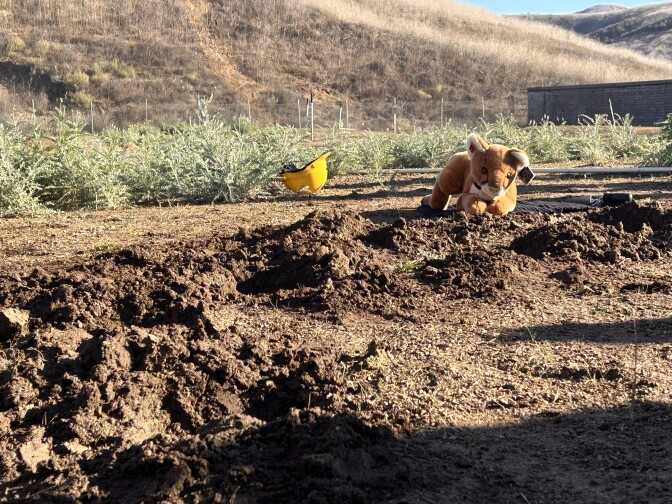Truth matters. Community matters. Your support makes both possible. LAist is one of the few places where news remains independent and free from political and corporate influence. Stand up for truth and for LAist. Make your year-end tax-deductible gift now.
Another milestone for ambitious 101 Freeway wildlife crossing: First native plants go in

Native plants are being placed on the Wallis Annenberg Wildlife Crossing Tuesday, marking another milestone for what officials say will be the largest bridge of its kind in the world.
Over the next few months, about 5,000 more plants are expected to be installed along the bridge — which stretches over all 10 lanes of the 101 Freeway in Agoura Hills — to help create a nearly one-acre wildlife habitat.
Once complete, the crossing is expected to reconnect areas traversed by Southern California mountain lions, bobcats, deer, bats, birds and other animals — big and small.
Beth Pratt, California regional executive director for the National Wildlife Federation, said during a planting ceremony atop the bridge that it’s emotional to see the soul of the project take shape.
“This was an impossible dream that started decades ago,” said Pratt, who is also leader of the Save LA Cougars campaign. “This is reconnecting the Santa Monica Mountains to the rest of the world — for all wildlife."
The Wallis Annenberg Wildlife Crossing is now in its final construction stage and is on track to be finished by the end of next year.

About the plants
The native plants, which include dozens of species sourced from within a 5-mile radius of the crossing in the Santa Monica Mountains, come from a nursery that was created specifically for the project. Officials said a nursery team spent the last four years collecting more than 1.1 million hyper-local seeds by hand to support the soon-to-be habitat.
They include narrowleaf milkweed, which is critical for the monarch butterfly population, purple sage, which attracts hummingbirds, and California aster, which provides pollen and nectar to bees.
The ceremony started with an Indigenous blessing and prayer led by Alan Salazar — also known as Puchuk Ya'ia'c or Fast Runner — an elder in the Fernandeño Tataviam and Ventureño Chumash tribes. He left an offering of tobacco and sage along the ground where the plants would be placed.
“We haven’t been too kind and gentle to Mother Earth, and we need to make up for some of those mistakes,” Salazar said as he scattered the offering. “Today, we’re making up for some of them.”
The first three plants were installed in honor of long-time project supporters who couldn’t be at the ceremony — actor Leonardo Dicaprio, Gov. Gavin Newsom and philantropist Wallis Annenberg, who died in July.
Pratt said there wouldn’t be a wildlife crossing without Annenberg’s help.
The other plants were installed by officials with Caltrans, the city of Agoura Hills, the Wallis Annenberg Legacy Foundation and the Santa Monica Mountains Conservancy, among other organizations. Pratt noted that the National Park Service researchers who worked on the crossing couldn’t be there to celebrate the milestone because of the ongoing government shutdown, which she said was “shameful.”
The plants will spring from specially engineered soil that was installed along the bridge in March and April. Officials said the roughly 6,000 cubic yards of soil — which is partly compost, branches and leaf litter — is comparable to what makes up the green sloping hills on either side of the busy freeway.
Scientists, biologists, engineers and mycologists designed the material to make sure it’s appropriate for native plants, animals and the crossing itself, officials previously told LAist.
“We're designing all the way from those microbial components all the way up to the apex predator,” said Robert Rock, president of Rock Design Associates, the landscape architecture company overseeing the project.
What’s next
Crews are making progress on a second structure that will add onto the current reach over the freeway. It’ll stretch over two lanes of the smaller Agoura Road, but it’ll be as wide as the one built over the freeway.

The second structure has required a “monumental” effort from multiple agencies, according to project officials, including burying high-voltage power lines underground, relocating several telecommunication lines and rerouting a regional waterline.
Pratt described it as the “most complicated” part of the project.
“We don’t want Calabasas and Agoura to lose electricity or their main water source, so we kind of have to go a little slow on that,” she said, adding that the crews expect to start constructing that structure early next year.
The entire crossing is expected to be completed by the end of 2026. In addition to helping animals cross safely over the freeway, it’s expected to restore an ecosystem damaged by human development, according to the Annenberg Foundation.
You can check-in on the project’s progress through livestream cameras here.
Listen to our podcast
For more information on L.A.'s famed wildlife, listen to Imperfect Paradise: Lions, Coyotes & Bears.



















